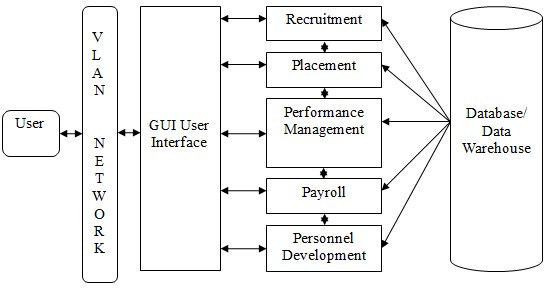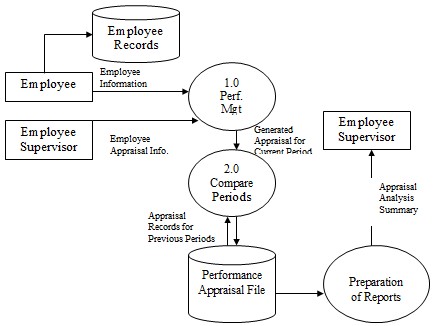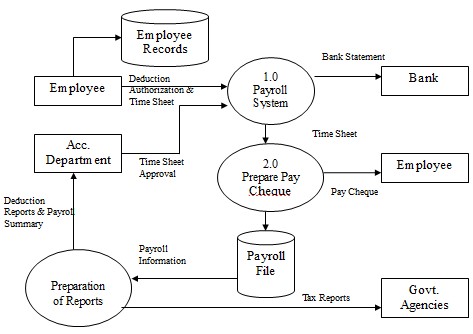Requirements, Feasibility and System Analysis
Information Gathering Techniques
The system that is to be implemented is an HR system that incorporates the business processes of an HR function through the automation of the processes and making the function more efficient, effective, and productive.
Before the HR system can be designed, it is impertinent that the requirements analysis needs to be done by gathering the requirements of the system from the project sponsor and the end-users and analyzing the best way that requirements can be incorporated in the system. “A strong requirements gathering process is essential for developing or purchasing the right software. Ultimately, successful performance is determined by the degree to which the software satisfies end-user needs. Requirements’ gathering is the process by which development or purchasing teams come to discover what the business and end-users require of a new application.
Poorly gathered requirements often result in software that fails to meet end-user needs and business objectives, and can lead to expensive rework, cost overruns, and missed milestones” (Requirements Gathering: What Every IT Manager Needs to Know). Therefore exhaustive information needs to be gathered in the requirements phase. In order to gather information from the project sponsor, formal interviews, as well as in-depth meetings can be set to discuss what the project sponsor, which is usually the top management of the organization, wants from the system. The specific needs and wants as well as the functionalities that the project sponsor expects from the system need to be sketched out.
Similarly, it is also important to gather information about the requirements from end-users of the system. This is important as the end-users are the ones who have to eventually use the system and their requirements can provide insight into what they think is needed and can help the HR function be more effective and efficient if automated through the HR system. In order to gather information from the end-users brainstorming sessions can be undertaken along with focus group-based interviews with the staff and survey-based questionnaires which can be used to determine what aspects of the system the staff prioritizes as requirements and what it deems as an additional service.
Key Factors to Ensure Successful Requirements Gathering
The key factor that can influence the success of the requirements gathering activity and initiatives are depicted below.
The first factor that is crucial for the success of the requirements gathering for an information system like the HR system is the commitment of the management to the project. The management needs to be wholeheartedly involved and in favor of the implementation of the information system and needs to provide insight through direct involvement in the requirements phase. Their commitment to the Hr system project can drive the individuals in the organization as well to perform better and better comprehend/ support the HR system.
The second critical factor for success is the communication and the two-way interaction between the Human Resource Management & Information System personnel and the end-users of the system. This is important as the increased and effective communication between these parties can help realize problems, issues, and requirements from the users which otherwise might not have been possible without the support of two-way communication.
Douglas Havelka and Sooun Lee have provided in their article that “defined as the agreement among management, user groups, and the IS department on the purpose of the project and the deliverables to be produced, goal congruence was rated the third most important factor to successful IS requirements gathering. This factor is directly affected by the existence and quality of a feasibility study and plan” (Havelka & Lee, 2007)
The fourth key success factor is the understanding of the HRM system personnel pertaining to the application required. The IT and HRM system personnel need to be aware of the tasks, the outputs as well as the business processes that the HRM system seeks to support.
The fifth key success factor which is crucially important for effective and good requirements gathering is an element of planning. The requirements gathering phase is the foundation of the HRM system development and as a result, proper and effective planning is needed which takes into account exhaustive research.
Scope and Feasibility
HRM Processes
The HRM function at the ABC company has the following main processes which need to be automated and integrated into the HRM system.
Recruitment: The process through which prospective recruits are screened, interviewed, and evaluated to select the most qualified personnel for the job at the company.
Placement: The process though which employees are matched with the jobs in the company according to their knowledge expertise, skill set and experience.
Performance Appraisal: The performance evaluation of the employees in the organization to monitor their performance progress and determine areas which need further development
Compensation: Rewards and Remuneration to the employees for their services provided to the company
Development of Personnel: the development of the employees at company through training, workshops, seminars, and career consultancy.
Goals and Objectives
The goals and objective of the HRM system project is do develop a system for the human resource manage function at the ABC company which would help automate the business processes of the HRM and while making them more effective, efficient as well as productive. The project is aimed at designing and developing a system which
- makes the utilization of the Human resources effective
- creates and develops organizational structure relationship
- enables development of the human resources
- provides best suitable rewards
- manages the motivation of the employees
- While also provides compatibility of the goal of the employee with that of the organization.
Scope and IS Applications
The HRM system which is an IS application would incorporate the all the processes of the HRM function at the company. The system would be based on modules and would have specific modules addressing the processes for recruitment, recruitment, placement, performance appraisal, compensation and personnel development.
Risks
The project for the design, development and implementation of the HRM system does present some risks as well. These risks are associated with
- The rejection that might be presented by the end user after the system is implemented
- The lack of cohesion of the system with the HRM practices and processes at the company
- Lack of proper integration with the legacy system
- High level of maintenance issues after deployment
- The system being to complicated for the management and the end users at the company
System Design
Application Architecture Design
The application architecture for the HRM is such that it is based on modules which cover the functions of the Human Resource Management at the ABC Company. The users of the system include the managers as well as the staff that is employed in the HRM department. The system architecture is such that the user can access the system through the company private VLAN network. The user interface is set up to be a graphical user interface as it provides ease of use and a friendly environment for the system usage. The GUI user interface is accessible via the VLAN network and directly links to the modules of the HRM system. These modules are namely recruitment, placement, performance management, payroll, and personnel development. Each of these modules are further linked with the database structure and the data base server. The database/ data warehouse stores current as well as historical records
The following diagram depicts the system architecture at a high level.

Application Process Design
Below are depicted the detailed description and the DFD for two of the modules/ processes. The performance management module shows how the employee records are retrieved form the data based and the employee as well as the employee supervisor provide the appraisal based information that is fed into the system. The performance management system then generates appraisal for the current period and compares it with the appraisal results for the previous periods which are also retrieved from the database. Reports are prepared which summarize the appraisal analysis and results. These reports can be viewed by the employee supervisor.

The payroll module clarifies how the employee records for an employee are retrieved from the database, while the time sheet as provided by the accounts department as well is fed into the payroll system. The payroll system then prepared the pay cheques which, a copy of which with the time sheet is kept is stores in the payroll file in the database. The payroll information is retrieved for preparation of reports which result in tax report generation that are submitted to the Govt. agencies. The pay cheque is provided to the employee while the bank statement is provided to the bank.

System Implementation
Activities in System Implementation
Coding
The coding activity involves writing down the code in an object oriented.net programming language for the process flow and the design of the different modules. The code will need to be written as per the customized requirements of the users based on the functionality that they require form each of the modules. Aside from this code will also be written to support querying and report generation from the modules as well as the entire HR system as a whole
Testing
The testing activity would involve testing the modules for their functionality with sample data to determine the effective and efficient working body of the modules. The errors and variances would be identified from testing. Aside from this an overall prototype would also be made to test the GUI user interface compatibility with the HRM system and to determine the compatibility with the user along with the entire cohesiveness of the system on the basis of the architecture.
Installation
The installation activity would involve launching the system for use in the company with the HRM staff and management provided access to the system to employ in their daily and routine business activities. The phased installation/ implementation style would be employed whereby for 2 months the employees would use the new HRM system and the next 2 months employees would use the legacy system. This will help identify any bottlenecks, problems and issues that might be present in the new system.
Documentation
Documentation is an important aspect of implantation as it is one of the main aids available to the users and the administrators of the system in the ensuring future. The documentation would involve writing and compiling detailed documentation for the information system processes and flow, while also compiling a separate documentation for the users and the system administrator. The documentation for the users will take the form of user manual and will help the current as well as any new employees that join the company ion the future to learn how to run and operate the HRM system
Training
As a new system is developed, it is also essential to enable the employees and the end users of the HRM system to use the system to its full capacity for efficiency and effectiveness. For this the employees as well as the management will need to be taught and trained on how to use the system. Pilot based training would be employed where the users can have first hand experience on the system. Aside from this training classes can be scheduled before the launch of the HRM to train the employees of the ABC Company on how they can use operate system.
Support/ Maintenance
Even after the implementation of the system, constant support and maintenance is requires as the ensuing months after the eiomplneh5taion can reveal issues and problems that were not forecasted or mitigated against during the development of the system. “Experience shows that most of the system management issues are functional, not technical. That suggests that functional staff – HR and Payroll should be custodians of the system – the HR system staff. I/T specialists can and should participate as part of the team (but not necessarily full-time reporting to HR).” (‘After the Implementation: Maintenance of Your New HR System’, 2005) As a result the a team made of IT technicians as well as managers in the HRM function like the recruitment & placement manager, the payroll manager as well as other heads of the HRM function would be provided rights to maintenance the system. The IT support can be provided by the technicians while the functional management can provide support in terms of the concept.
Benefits of Repeatable Processes in Implementation
By making the implantation stage activities and processes defined while enabling the activities and processes to be repeatable, the system can become more effective and flexible. The reason for this is that during the implementation phase, the system project manager and team might have to go back and forth between coding and the rest of the activities to make the required changes and adjustment for the effective and efficient operation of the system. By keeping the processes and activities repeatable this can be easily achieved and the integrity of the implemented system can significantly increase.
References
After the Implementation: Maintenance of Your New HR System, Canadian HR Reporter. (2005). Web.
Havelka, D., Lee, S., (2007), Critical success factors for information requirements gathering, Auerbach Analysis. Web.
Requirements Gathering: What Every IT Manager Needs to Know, Research and Markets. Web.
System development Life Cycle and prototyping. Web.
